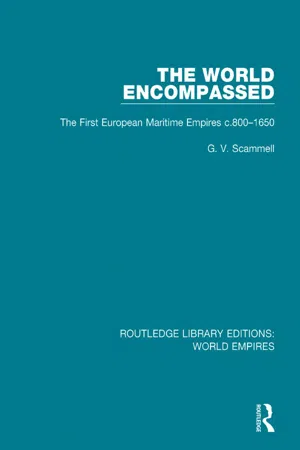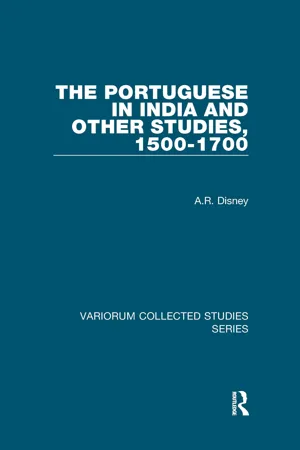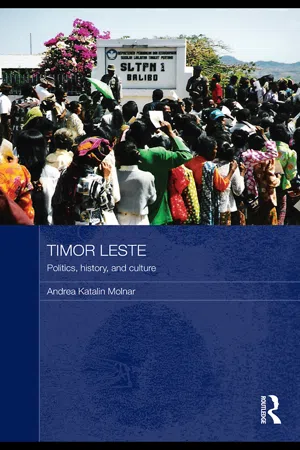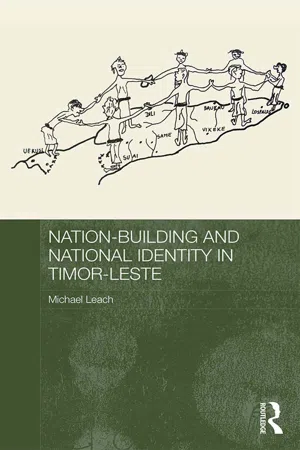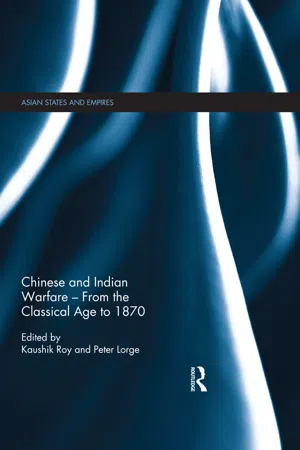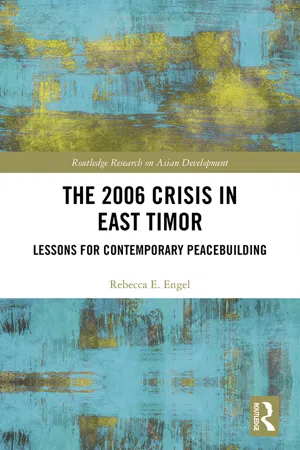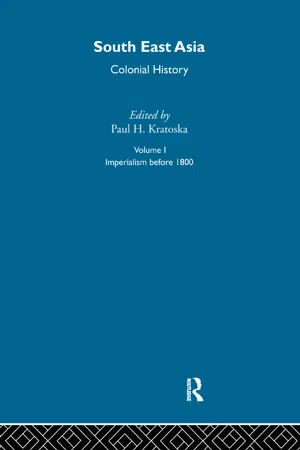History
Portuguese East Indies
The Portuguese East Indies refers to the territories in Southeast Asia that were colonized by Portugal in the 16th and 17th centuries. These territories included parts of present-day Indonesia, such as the Maluku Islands and Timor. The Portuguese established trading posts and exerted influence in the region, particularly in the spice trade.
Written by Perlego with AI-assistance
Related key terms
Related key terms
1 of 4
Related key terms
1 of 3
8 Key excerpts on "Portuguese East Indies"
- Om Prakash, Om Prakash(Authors)
- 2020(Publication Date)
- Routledge(Publisher)
Portuguese participation in the pepper and spice trade caused a rise in prices and led to increased production of these commodities. Both pepper and spice production spread out into new areas. The influx of foreign merchants had the effect of alerting the coastal potentates and making them aware of the great value of the local products. A scramble for pepper and spices had begun. Many of the coastal kingdoms began to extend their territories with a view to reach out to the areas of production and the ports acting as outlets for these products. Acheh threw up a little empire along the east and west coasts of Sumatra. Ternate and Tidore and Later Macassar extended their respective areas of control. The same process operated in north Java.The Portuguese attack on Malacca in 1511 coincided with the spread of Islam along the coasts of Indonesia. One may not agree with Schrieke that the Portuguese presence sparked off a race between Christianity and Islam in Indonesia, but undoubtedly there was a quickening of zeal for Islam during this period in the coastal regions. But the opposition between Christianity and Islam should not be overstressed because there was no unity among Muslims and no desire to combine against Christian powers. The sultanates were as bitterly opposed to one another as they were to the Portuguese in Malacca. Religion may not have been as important a factor as it appears on the surface. The Portuguese, however, conditioned the political atmosphere in a different way. They were the major importers of firearms in this area. Individual Portuguese entered the services of southeast Asian kingdoms and helped in spreading the knowledge of firearms. In this sense the Portuguese were partly responsible for aggravating the intense political rivalry within the Indonesian archipelago.The Seventeenth Century
For many historians of Indonesia the seventeenth century opens with the Anglo-Dutch assault on the Portuguese and Spanish positions in the East accompanied by Anglo-Dutch rivalry to dominate the spice trade. These episodes acquire importance not only from the point of view of European expansion in Asia. Even from an Indonesian point of view the dominant European power in the region often provide us with a convenient focus. Historians have vainly looked for a focus in Indonesia. In the period of European interference one can look at the interaction of Indonesian states with the major European power as a convenient central theme. One can begin by asking the question : where do Indonesian states stand in relation to the Dutch East India Company? It is possible to write a meaningful account of Indonesian trade and politics in the seventeenth century in terms of this question. Yet it seems imperative at this point to plead for an alternative viewpoint. European activities should be seen within the dynamics of Indonesian trade. Furthermore the interrelation of Indonesian states should be given the weightage it deserves. It is essential to grasp that the evolution of trade and politics in Indonesia has a rhythm of its own. There is a constant tendency to reach a structural balance in the archipelago between the East and the West. What D.G.E. Hall calls the ‘ding-dong battle between Sumatra and east Java’ reflects the perennial see-saw, the everlasting fluidity of a shifting balance which paradoxically holds the archipelago together. When Srivijaya gave some sort of unity and cohesion to western Indonesia it was attacked by east Java which had friendly ties with the Cholas. Then the focus shifted to Java which became the core of the Majapahit empire. The sultanate of Malacca (1400–1511) once again recaptured for western Indonesia the position it had once enjoyed under Srivijaya. The Portuguese conquest in 1511 eventually destroyed the unity of the Malay empire. For a time the unicentred pattern of Indonesian trade was replaced by a multicentred arrangement. This situation continued until the Dutch made Batavia the nucleus of a Java-based commercial network which sought to encompass the entire archipelago. Historians have tried to examine the extent of European influence on Indonesian trade. It is fruitful to explore to what extent the outsiders were forced to come to terms with the situation in the archipelago. The compulsions of the trading environment in Indonesia obviously set limits to the course of action to be adopted by the Europeans.- eBook - ePub
The World Encompassed
The First European Maritime Empires c.800-1650
- G. V. Scammell(Author)
- 2018(Publication Date)
- Routledge(Publisher)
Nor was this the limit of Portuguese endeavour. Japan itself was found, Viking-style, purely by accident when a party of would-be China traders was blown there by a typhoon (1543). To their delight they encountered people less haughtily contemptuous of foreigners than the Chinese and with so avid a desire for the products of Europe and China as to make their country ‘one of the best and most suitable … for gaining profit’. Earlier the Portuguese had reached Siam and Burma, besides establishing posts in eastern India. Some uncertain authority also came to be exercised over Ceylon, rich in cinnamon, elephants – used in war and ceremony in India – and precious stones. Straddling the shipping routes from the Arabian Sea to the Bay of Bengal and southern Asia, and politically weak, it appeared to bold strategists the ideal base for privateering, and the possible seat of a great eastern realm.These fanciful dreams were not realized, and by the mid-1500s Portugal’s Asian empire had reached its fullest extent. Individuals were indeed to penetrate further still, merchants or seamen to Manila, New Guinea and the Seychelles in the later sixteenth century; missionaries to Vietnam and Tibet in the early 1600s. At the same time local hostility, European competition, and the ever-growing power of Islam brought a search for new bases and new allies. Nevertheless the essential character of the empire remained unchanged. Whatever the grandiose titles concocted at home, or the bellicose language of imperial correspondence, the Portuguese were notoriously not, as were the Spaniards in America, rulers by conquest of subject millions. Their territorial possessions were few; colonization – in face of a hostile climate, organized and populous Asian societies, and their own demographic weakness – was insignificant. Instead, Portugal’s eastern empire was a string of fortresses and factories – the very worst to defend – sustained by, or potentially controlling, maritime trade routes. In this, though the product of a remarkably non-mercantile society, it resembled those of the Hanse and Venice. Similarly, as in their empires, long-distance trades were complemented, and often overshadowed, by local ‘country’ traffics. And, as with Genoa, the fragile authority of the parent community and the limited opportunities it offered, encouraged individuals to trade where the flag of the mother country could never hope to follow, and ensured that Portuguese commerce long survived the demise of Portuguese rule. But Portugal enjoyed nothing of the economic hegemony of the German or Italian cities. Her commercial monopolies were less effective, and her empire – isolated survivals apart-far shorter lived. Simply a seapower of modest strength, she controlled no inland bases, and stimulated no such spate of urban foundations as the more intensively commercial Hanse. And reflecting its peculiarly monarchical and aristocratic origins, Portugal’s empire was largely geared to plunder, and to the conduct of a trade even more exclusively devoted to luxuries than that of Venice (cf. pp. 101ff). - A.R. Disney(Author)
- 2023(Publication Date)
- Routledge(Publisher)
II The Portuguese Empire in India c. 1550–1650 Some Suggestions for a Less Seaborne, More Landbound Approach to its Socio-Economic History Some forty-five years ago J. C. Van Leur commented to the effect that historians seemed too often to be viewing Asian history from the very limited perspective of an East Indiaman’s deck. 1 Insofar as this criticism referred to explicit assumptions of European superiority it is probably for the most part no longer applicable; but in respect of Eurocentric preoccupations it remains, at least in certain areas, substantially valid. This is demonstrably so with many studies in the economic history of the Portuguese empire in Asia which, while they have in some cases achieved great advances in our knowledge and understanding since Van Leur, have nevertheless been largely confined to the essentially European-orientated themes of maritime trade and communications. 2 The reasons for this concentration are fairly clear. It has long been a practically unquestioned historiographical assumption that the Estado da India was, in its economic aspect, almost exclusively a maritime trading empire, and had very little territorial importance or interest. The notable Indian historian K. M. Panikkar, while he cogently exposed some of the European prejudices that had characterized earlier writing on Europe in Asia, appears to have been particularly anxious to stress the Portuguese empire’s alleged territorial insignificance — thereby indirectly reinforcing the traditional emphasis on its trade and shipping. 3 Western economic historians in this field have overwhelmingly maintained these preoccupations. This is doubtless partly because the European documentary sources for the history of Portuguese seaborne commerce in Asian waters are comparatively rich, and have offered opportunities for fruitful research- eBook - ePub
Timor Leste
Politics, History, and Culture
- Andrea Katalin Molnar(Author)
- 2009(Publication Date)
- Routledge(Publisher)
There is a multitude of quality historical sources which discuss this period of impact on the historical development of the people of Timor Island; however, in the following overview I am mainly concentrating on the accounts of those that focus on the historical experiences of Timor Leste in particular (see for example, McWilliam 2002; Fox 2000; Matos 1974; Felgas 1956; Castro 1943; Gunn 2001; Duarte 1944; Leitao 1948 and 1952; Martinho 1943, 1945, and 1947; Metelo 1922; Schlicher 1996; Sherlock 1983; Therik 1995; Vasconcelos 1937; Pereira 1940; Oliviera 1949; 1950, 1952; Morais 1934, 1944; Webb 1980; Kohar 1998; Hiorth 1985; Tanter et al. 2001a among others). This period has several significances for the socio-political development of Timor Leste, as I shall discuss below. The people of Timor Island were caught in the tug-of-war of political-economic struggle between the Dutch and the Portuguese—a struggle that precedes the colonial presence of either power on Timor, and had lasting political and territorial consequences into the present. In territorial terms, Timor Island became divided into western and eastern parts during this colonial period of history. Therefore, the roots of the current division of Timor Island between the nations of Indonesia and Timor Leste lie in this period.While the interests of the Portuguese in Timor were mainly focused on the sandalwood trade, by the early sixteenth century their presence on the island was mainly represented by early Catholic missionaries (Gunn 2001; Felgas 1956; Matos 1974; Morais 1934; Vasconcelos 1937). By 1515 a few Dominican priests had introduced Roman Catholicism to the island. However, the 1556 arrival of the Dominican friar, António Taveira, officially marked the commencement of a more widespread missionizing effort. The Church’seffort concentrated on the north and south coastal chiefdoms during the late sixteenth century. It should be emphasized, however, that these were only a handful of priests setting up isolated Catholic missions and it took them almost 100 years (by 1640) to set up 10 missions and 22 churches on Timor. Therefore, initially it was not a Portuguese colonial administration, nor trading posts nor military garrisons that were present on Timor Island. These Portuguese penetrations happened gradually and in reaction to Dutch and Portuguese relations in the neighboring islands and then in west Timor. Thus it is not appropriate to talk about Portuguese colonialism beginning in the sixteenth century. Therefore, it may be useful to briefly review the process by which the Portuguese gained and enhanced their foothold on Timor Island and when and if one may talk about colonialism (cf. Fox 2000). - Michael Leach(Author)
- 2016(Publication Date)
- Routledge(Publisher)
liurais in his description of the colony (Forbes 1885). These established modes of European-Indigenous relations would change dramatically at the beginning of the twentieth century with the intensification of Portuguese colonial authority.What, then, was the impact of the first three hundred years of Portuguese colonialism on the development of a sense of collective identity in East Timor? It seems clear that the indigenous governance of many, if not most, traditional reinos remained largely intact, though modified over time by tributary relationships and periodically violent contacts with Portuguese authority, and by the transformative impact of the Topasses in certain regions. Accommodation to the Portuguese system of consistent military ranks had also introduced elements of hybrid commonality in relation to external power. As Pelissier notes, despite movements to drive the foreigners from the island in the mid-nineteenth century, the attachment to Portuguese flags as lulik objects and ranks was strong (1996: 45). The coastal enclaves were a clear exception to this model of indirect rule, with long-term impacts including the disruption of lisan and weakness in traditional authority in areas of longterm settlement, such as Dili, Lifau and Manatuto. In these enclaves, defended by forts and linked by coastal trade to Dili, new forms of economic production for coastal trade had already driven the development of creole languages facilitating communication between occupier and indigenous; for example, the now extinct Portuguese of Bidau and early Tetun-Praca. Yet traditional ways of life for non-elite Timorese remained essentially unchanged outside these zones of influence, with subsistence economies and the legitimating ideologies of lisan essentially intact.The practice of educating the sons of the liurais in Portuguese was introduced under Governor De Castro (1859–1863). As de Castro explained, the policy was explicitly aimed at the cultivation of Portuguese values among the indigenous elites: ‘We suggested that a college be founded to educate the children of the principal indigenous chiefs. … It is of the utmost importance that the Timorese rulers know about our civilisation, which is the only way of dealing with the customs of the barbaric peoples’ (cited in Araujo 1975: 4). This joined a series of political and economic policies designed to reconfigure traditional Timorese society. By the time of de Castro, liurais had been ordered to grow coffee and surrender 20 per cent of proceeds to the Crown (Jannisa 1997: 88), a practice that once again prompted revolts by interfering in land use, a key domain of liurai- Kaushik Roy, Peter Lorge(Authors)
- 2014(Publication Date)
- Routledge(Publisher)
9 Indo-Portuguese naval battles in the Indian Ocean during the early sixteenth century K.S. Mathew DOI: 10.4324/9781315742762-9The discovery of the direct sea-route connecting the Indian Ocean regions with the Atlantic ports by Vasco da Gama, the undaunted admiral of the Indian Ocean, and the subsequent establishment of Portuguese factories and fortresses on the coastal regions of the subcontinent of India are considered important milestones in world history. The sixteenth century witnessed a significant encounter between the West and the East in the socio-economic realms. The Westerners observed with great interest whatever they came across in the East and reduced to writing most of the interesting aspects of life in the East to which probably an Indian observer paid only scant attention. The rich corpus of information available in the Portuguese archives and libraries throws considerable light on the naval activities of Indians and especially the Indian encounters with the Portuguese. The present study is an attempt to highlight some of the aspects of the Indo-Portuguese naval battles during the early decades of the sixteenth century. Contemporary European as well as ‘native’ sources are made use of in the preparation of this chapter. This period is chosen chiefly for the sake of brevity and also because of the fact that the Portuguese during this point of time had confrontations with the Indians on the eastern as well as on the western coasts of India and by this time they had established a sort of naval supremacy in the Indian Ocean regions.Indian ships were found in the far-flung regions of the Indian Ocean before the arrival of the indefatigable mariners of Portugal. When Vasco da Gama reached the East African coast, there were Indian merchants in Moçambique, presumably Gujaratis, selling cloths, cloves, pepper, ginger, pearls, silver rings and rubies, most of which was taken to the East African coast by vessels from India. Huge vessels sewn with coir and propelled with the help of veils made of palm trees, owned by Indian merchants used to leave for Soffala.1- eBook - ePub
The 2006 Crisis in East Timor
Lessons for Contemporary Peacebuilding
- Rebecca E. Engel(Author)
- 2020(Publication Date)
- Routledge(Publisher)
1 In the words of anthropologist Shepard Forman, Timor-Leste “manifests an ethnic heterogeneity which characterizes the entire region from the Philippines to Australia and from the islands east of Papua New Guinea to the Malagasy Republic” (cited in Dunn, 1996:2). This perhaps can be attributed to the island’s position in pre-European trading networks “centred politically on East Java and … tied into commercial links with China and India” (Taylor, 1999:1). Historically a land comprised of over 40 rival kingdoms, modern Timor-Leste continues to be informed and shaped by relationships between the owners of land and animals, those with political and/or ritual authority, commoners and those who are descended from slaves.The economy of the pre-colonial island of Timor depended on seasonal cultivation of crops, fruits and livestock. “Economic relations were not merely influenced by division in the production process, however. They were also influenced by a system of exchange, involving both goods and individuals. Goods were extracted from Timorese communities as tribute to the chiefs of the various princedoms and kingdoms” (ibid.:6). The performance of rituals and exchanges during life-cycle events such as births, deaths and weddings was considered essential to the maintenance of political and economic stability (ibid.:8) as well as harmony with the social order and thus with the ancestors. Conflict was mediated by customary practices that were specified according to time and place. Warfare was often “localized and resulted from demographic pressures, conflict over the resources for and spoils of trade, and questions of the heart” (Forman, 1977:103).Colonization and its consequences
Timor-Leste became part of the Portuguese colonial dominion in the mid-sixteenth century, but it was only after 1642 that the Portuguese invaded Timor with greater force (Carey and Bentley, 1995:2; Taylor, 1999:4). Even then, Portugal only penetrated Timor’s coastal areas (Forman, 1977:100) and it was not until 1769 that the Portuguese moved their capital to Dili from Lifão (present day Oe-cussi) (Traube, 1986:52, 252). Portuguese Timor’s particular political trajectory can be differentiated from that of West Timor, a Dutch colonial territory until Indonesian independence in 1945. Forman describes “the political reality in Timor at the time of the European discoveries, in so far as we can know it … [as] atomistic and centrifugal”. Trading relations were embedded in a “nested hierarchy of clan groupings” and there were no unifying power structures in line with modern European conceptions of a state (Forman, 1977:103); kings2 controlled territories made up of tribal groups, which consisted of a number of clans, with the support of ritual authorities (Dunn, 1996:3).3 - eBook - ePub
- Paul Kratoska(Author)
- 2022(Publication Date)
- Routledge(Publisher)
The Estado da India may also have owed some of its characteristics as a commercial network, at least in South East Asia, to the earlier trading empires of an only quasi-territorial nature that had preceded it in the region. Still evident to the first Portuguese to venture into South East Asian waters was the precedent of the Javanese empire of Mojopahit, which in the fourteenth century had attained power and prosperity, both by developing its capacity as a major producer and exporter of rice and by gaining control of most of the important trade routes in the Indonesian archipelago, and which yet had only exercised a very tenuous suzerainty over the more distant parts of its island realm. The last recorded ruler of Mojopahit, Pati Udara, sent envoys to Afonso de Albuquerque in Malacca in 1512 to enlist his support against the Muslim port sultanates on the north coast of Java. An even more immediate example was afforded by Malacca itself, which the Portuguese captured in 1511 in order to gain control of the valuable international trade of which it was then the leading entrepôt and emporium in South East Asia and to which it owed its wealth and importance. It is, however, unlikely that the Portuguese adopted the practice of commercial expansion, without territorial conquest or subjugation of indigenous populations and without attempting to take control of the means of production, in conscious imitation of these earlier states. They seem rather to have striven to follow the example of their contemporary trading rivals in the area. The only essential differences, indeed, between the Portuguese and the Malays, Javanese and other peoples who participated in this South East Asian trading network at the time the Portuguese arrived was that they were not Asians and that they were concerned solely with the circulation and exchange of goods and not at all with their production.Map 1 South East AsiaIn the Atlantic Ocean the Portuguese were voyaging in ‘seas never previously navigated’ (mares nunca doutrem navigados), where they had no commercial rivals and could create their own trading network without damaging anyone else’s interests. Not so in the Indian Ocean and the Indonesian archipelago, where they at once encountered both the commercial rivalry and the religious antagonism of the numerous Muslim peoples with whom they had perforce to deal. It was this that gave the Portuguese trading empire in Asia its essentially military character, and paradoxically made the fortaleza an institution more characteristic of it than the feitoria.However, initially there were no plans for founding a territorial empire by force of arms. Profitable trade was the first aim and to achieve this the Portuguese depended upon the goodwill and cooperation of local rulers. It was thus an essential element of Portuguese policy to establish friendly relations with these rulers and to win the obedience of their subjects, as far as possible by peaceful means. The instructions given in 1506 to D. Francisco de Almeida, first governor and viceroy of India, make this point very clearly. Almeida was told to set up a fortress in Malacca but to avoid conflict with the local people and to explain to them that the fortress was solely for the protection of the Portuguese and their merchandise and not built with any warlike intent. He was instructed to send ships thence to Sumatra, ‘which is near Malacca and said to be a very rich island’, and to ‘the island of cloves and other important islands adjacent to it, which we are informed are very rich and from which much profit can be derived’. He was to sound out the position of these islands and do whatever he deemed necessary as a mark of possession (that is, set up a padrão or commemorative pillar with the royal arms and a cross on top) and to try to ‘subjugate and bring to our obedience the kings and lords of the islands, make them our tributaries, and agree with them on how this can best be done for our service’.3 Three years later, when Afonso de Albuquerque was planning to attack Malacca, be proposed an alliance with the king of Ayuthya, to whom he offered sovereignty over the territories ruled by the sultan of Malacca if the attack was successful, since the Portuguese themselves only wished to utilise it as a commercial centre and military and naval base. Ayuthya showed no interest in this offer, so Albuquerque went ahead alone and took Malacca unaided. Nevertheless, after the conquest of the city he did nothing to subdue the rest of the sultanate or to dispossess its ruler.4
Index pages curate the most relevant extracts from our library of academic textbooks. They’ve been created using an in-house natural language model (NLM), each adding context and meaning to key research topics.
Explore more topic indexes
Explore more topic indexes
1 of 6
Explore more topic indexes
1 of 4

